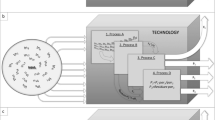Abstract
This paper explores the use of LCA as a tool for process environmental management, thereby moving the focus from product to process oriented analysis. The emphasis is on Improvement Assessment in which the “hot spots” in the system are targeted for maximum environmental improvements. In this context, it is useful to use multiobjective optimisation which renders Valuation unnecessary.
The approach is illustrated by the case study of the system processing boron ores to make five different products. The results of Inventory Analysis and Impact Assessment are presented and discussed. In Improvement Assessment, a number of improvement options are identified and evaluated, using system optimisation. It is shown that the site environmental performance can be improved over current operation by an average of 20% over the whole life cycle. Thus the study demonstrates that the optimisation approach to environmental process management may assist in identifying optimal ways to operate a process or plant from “cradle to grave”. This may help the process industries not only to comply with legislation but also provide a framework for taking a more proactive approach to environmental management leading to more sustainable industrial operations and practices.
Similar content being viewed by others
References
AZapagic, A. (1996): Environmental System Analysis: The Application of Linear Programming to Life Cycle Assessment. PhD Thesis, University of Surrey, Guildford, UK
Azapagic, A. andR. Clift (1998): Linear Programming as a Tool in Life Cycle Assessment. Int. J. LCA 3 (6) 305–316
Azapagic, A. andR. Cuft (1999a): Allocation of Environmental Burdens in Multiple-function Systems. J. Cleaner Prod. 7 (2) 101–119
Azapagic, A. andR. Cuft (1999b): Life Cycle Assessment and Multi-objective Optimisation. J. Cleaner Prod. 7 (2) 135–143
Azapagic, A. andR. Clift (1999c): Allocation of Environmental Burdens in Co-product Systems: A Case Study. Int. J. LCA, submitted
Clift, R.,R. Frischknecht,G. Huppes,A.-M. Tillman andB. Weidema (eds.), (1998): Toward a Coherent Approach to Life Cycle Inventory Analysis. Report of the Working Group on Inventory Enhancement, SETAC-Europe
Consoli, F.,D. Allen,I. Boustead,J. Fava,W. Franklin,A.A. Jensen,N. de Oude,R. Parrish,R. Perriman,D. Postlethwaite,B. Quay,J. SÉguin andB. Vigon (eds.), (1993): Guidelines for Life-Cycle Assessment: A ‘Code of Practice’. SETAC, Brussels
Council Directive 91/61/EC (1996) Concerning Integrated Pollution Prevention and Control. Official Journal of the European Communities, No.L 257, 10 Oct. HMSO, London
Heijungs, R. et al. (eds.), (1992):Environmental Life Cycle Assessment of Products: Background and Guide. MultiCopy, Leiden
PIRA International (1994). PEMS.2-Database. PIRA International, Leatherhead, Surrey, UK
Pearce, D.W. (1983): Cost-benefit Analysis. 2nd ed. Macmillan, London, pp. 112
PRé Consultants (1995): SimaPro — Database, PRé Consultants, The Netherlands
Udo de Haes, H.A.,J.F. Bersahel,R. Clift,C.R. Fussler,R. Griesshammer andA.A.Jensen (1994): Guidelines for the Application of Life Cycle Assessment in the EU Ecolabelling Programme. European Commission, DG-XI-A-2, Brussels
US EPA (1985): Compilation of Air Pollutant Emission Factors. Volume I and II, Fourth ed. US EPA, Research Triangle Park, North Carolina
World Resources Institute(1991): The 1992 Environmental Almanac. Houghton Mifflin Company, Boston
Author information
Authors and Affiliations
Corresponding author
Rights and permissions
About this article
Cite this article
Azapagic, A., Clift, R. Life cycle assessment as a tool for improving process performance: A case study on boron products. Int. J. LCA 4, 133–142 (1999). https://doi.org/10.1007/BF02979447
Received:
Accepted:
Issue Date:
DOI: https://doi.org/10.1007/BF02979447




